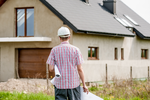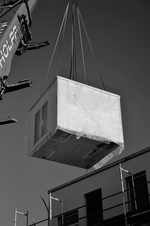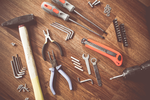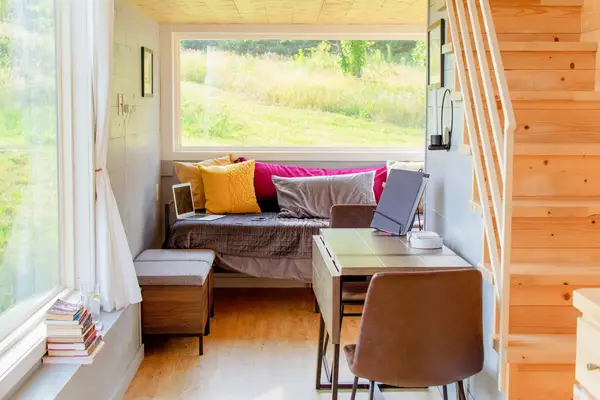So many people today are looking at building their own tiny houses, as the demand for alternative (and more minimalistic) living options have exploded. Building your own tiny house is affordable, easier than a full-size build, and gives people a sense of fulfillment that they are building a more sustainable home with their own two hands.
And while a ‘do it yourself’ attitude is amazing to have, for some of us building a home from scratch isn’t always viable. That’s where the tiny house kit comes in!
But how do you build your own tiny house kit? Well, here are DIYGazette’s top tips and guidelines on how to prepare for and get through a tiny house kit build while keeping safe (and sane)!
What is a Tiny House Kit?
First, if you don’t already know what a tiny house kit is, it’s blissfully simple. These kits provide all of the materials, particularly the frames and trusses that will make up your home. Kit house sellers will send flat packages of precut materials that simply need to be taken out and assembled (and in some cases, parts may already be partially assembled).
They also come with a set of step-by-step building instructions and floor plans so you know exactly what you’ll be building, and how to do it. It may also come with customizations should you arrange them.

Choosing to buy and build your own tiny house kit comes with a number of advantages. For example:
- They are generally more cost-effective than buying pre-built or building your own tiny house.
- Very customizable. Most tiny house kit sellers will allow their customers to adjust and add to the kit based on their own needs or wants.
- They are much easier to build than starting from scratch. This is especially helpful if you have minimal or no prior building experience, but want to build your own home.
- If you don’t want to hire skilled labor to help with the build, it is possible to build your own tiny house kit by yourself.
Tips For How To Build Your Own Tiny House Kit
1. Choose Your Kit
Before you can get a building permit you need an engineer to sign off on floor plans, which, coincidentally, you can only do once you’ve got your do-it-yourself tiny house kit chosen first.
Do you want to build your house on a trailer, so you can transport it at will? There are tiny house kits that come with trailers. Or do you prefer to build directly onto a slab? Then you’ll want a kit without a trailer. Do you want customizable options? Do you want something more rustic looking, like a cabin-style tiny house? Or something more modern?
Whatever you choose, you need to do two things: 1) figure out exactly what you want, and 2) do plenty of research to see what kind of options you have. Depending on where you live, options to pick up or have your kit delivered may be minimal, so you may have to contact numerous businesses in the process.
2. Find Out What You Can Build
If you’ve never built your own house before (and let’s face it, most of us haven’t) then you could be forgiven for not realizing that you need to make sure your house is legal before building it. That means checking out building permits and local zoning codes – i.e, keeping the build compliant with any building laws.

In some countries, provinces, and states, zoning laws require you to build residential buildings to be a certain size (usually a minimum of 1000 square feet) before you can get a building permit. If this is the case, you may find that you’ll have to relocate somewhere with less restrictive codes.
Make sure you can get a building permit before you start on any of the construction, as you can’t legally build a dwelling (even a kit house) without one. The length of the average tiny house kit tends to be around 3600mm to 12000mm, so make sure you know what size will best fit your situation.
On the other hand, you can also consider building on a trailer, as in many places a tiny house built on a trailer is considered a mobile home, so you can keep it on a property without having to deal with these issues.
Whatever you do, don’t be tempted to do an illegal build. There are a ton of tiny house builders who choose to avoid what can seem like overly restrictive zoning laws and permits by secretly building their homes and hoping their local council never finds out. Some people get away with it, but in the case that you’re caught, your entire dwelling will be destroyed.
3. Consider Custom Changes
If you want to add custom changes to the tiny house kit you’ve chosen, it’s best to consider this and pinpoint what you want before you place any orders.
A lot of tiny house kit makers will take their customers’ needs into account and make adjustments/add extras to your kit for an additional cost. These optional upgrades and custom features usually include things like skylights, internal doors, hardware, electrical wiring, and more. Make sure to call or have an in-house consultation with your provider so you know exactly what services they provide.
4. Get Your Budget In Order
This will cover your tiny house kit, extra equipment you may need to purchase, wiring and plumbing you may have to carry out yourself, and delivery fees if the kit is being delivered, administrative/council fees, and any labor fees you may need to pay if you are hiring contractors.
It can be easy to underestimate how much a build will cost, especially if you’re only considering the initial cost of the tiny house kit. But if you don’t take everything into account, you could end up running into financial issues in the future. There’s nothing worse than getting halfway through a build only to realize you’ve run out of money, and having to wait for months to recoup the rest of your finances.
5. Make Sure You Have The Right Equipment

The majority of tiny house kits you can buy will come with all the materials you need, but none of the tools you need to put everything together. You want to make sure you have all the right equipment at hand so you’re not scrambling for anything and holding up construction once you’ve started. It’s a small but vital way of ensuring that things run smoothly.
If you’re lucky, your tiny house kit will have a list of necessary tools. If not, here’s some of the equipment you are likely to need to build your own tiny house kit:
- Level
- Cordless drill
- Measuring tape
- Hammer
- Framing nailer
- Staple gun
- Drill + Drill bits
- Clamps
Keep in mind that you may need more, depending on your build.
6. Go Over The Plan
All tiny house kits will come with a detailed floor plan and building instructions for you to follow. You should have a thorough look through every step of the build before you start, particularly if you have limited experience with construction. This will give you more confidence when you undertake your build, and you’ll spend less time second-guessing, backtracking, and making simple mistakes because you’ve forgotten exactly how to do something.
7. Start building!
It’s time to build your own tiny house kit! From here on out, it’s a matter of following the kit building guidelines and blueprints and making sure you keep on top of both your own tasks and the tasks of whoever might be helping you.
Your plan should include, at a minimum:
- Elevations
- Floor Plans
- Building Sections
- Framing Details
- Roof Details
- Window Schedule
- Door Schedule
If you are choosing to forego hired contractors, it’s also up to you to make sure you’re observing proper workplace safety procedures. Building a tiny house kit may be faster and easier than a traditional build, but it still absolutely requires thorough safety checks and careful construction procedures.
With an extra person helping you build, some tiny house kits can take just 40 hours to complete. So remember to be as safe and as thorough as you can, and always follow instructions to a tee. Building a tiny house yourself might seem scary, but a ‘do it yourself’ project like this is actually more straightforward than you might expect.
It’s easy to feel daunted and put off when you first start to build your own tiny house kit, but you don’t need to feel this way! Following the steps above will ensure that the process goes as smoothly as possible, and you’re fully prepared for any issues that might arise along the way.


